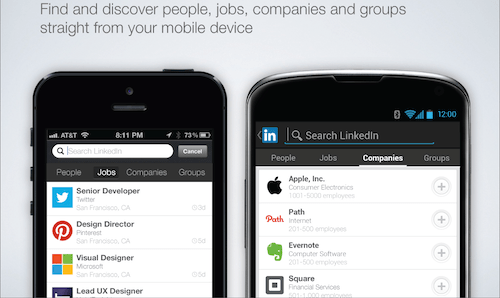Following LinkedIn’s overhaul of its mobile applications in April, the company today rolled out another major upgrade for its service on mobile, which now allows users to do more than search for other people — it also lets you search for Companies, Groups and Jobs. These additional search options appear after you tap into the search box at the top of the app. Plus, even if you don’t kick off a keyword search, you can tap through the categories to see a list of your LinkedIn connections and groups, as well as companies you follow or jobs available to you.
The move comes at a time when LinkedIn is working dutifully to transition its business to mobile, as so many of the early web giants — including Facebook — are also now doing. To aid in these efforts, LinkedIn this spring acquired a mobile-focused team from polling app Maybe, and more notably the popular newsreader Pulse for $90 million. With the most recent mobile update before today’s — which at the time was the first big upgrade in nearly two years — the focus was on building a personalized activity stream for app users, improving navigation, and introducing ads in the form of sponsored content in the main stream.
Though the new changes are now focused on search and discovery, the overall goal is the same: the company wants users to spend more time in the app, which is still used more sporadically when compared with the Linkedin.com website.
This is somewhat alluded to in the blog post announcing the upgrade, which presents a variety of use cases that take advantage of the new features, including things like keeping track of industry intelligence or colleagues’ promotions, browsing groups or looking for jobs. The post encourages users to “take advantage of your ‘in between’ moments throughout the day,” which positions LinkedIn on mobile as an app meant to become a daily habit, not just a utility you dust off when updating your resume.
Like other businesses that first established themselves as web companies, LinkedIn has a large feature set that it’s still figuring out how to properly port to mobile. In April, Joff Redfern, head of mobile products for LinkedIn, admitted that “it’s hard to get everything that LinkedIn does on to a single application on a small screen.”
To date, the company has split up some of its functionality between apps, with its card-scanning function (via acquisition) maintained in an app called CardMunch, while its Contacts section on the web became a standalone personal assistant app, Contacts for iPhone. There’s still room for LinkedIn to split off more of its features into dedicated applications, if it ever chose to do so in the future, but it would need to be careful not to overly fragment its user base, if so.
Supporting mobile isn’t only about addressing a general shift in computing, it’s about supporting those users worldwide whose first Internet-connected device may be their smartphone. LinkedIn has already said that 64 percent of its overall member base is from non-U.S. markets, which includes a number of emerging regions, and the mobile explosion happening now in China.
LinkedIn today offers access to more than 225 million professionals, 3 million Company Pages, 2 million Groups and thousands of job opportunities, all of which are searchable through the updated applications, live now in Apple’s App Store and Google Play.
